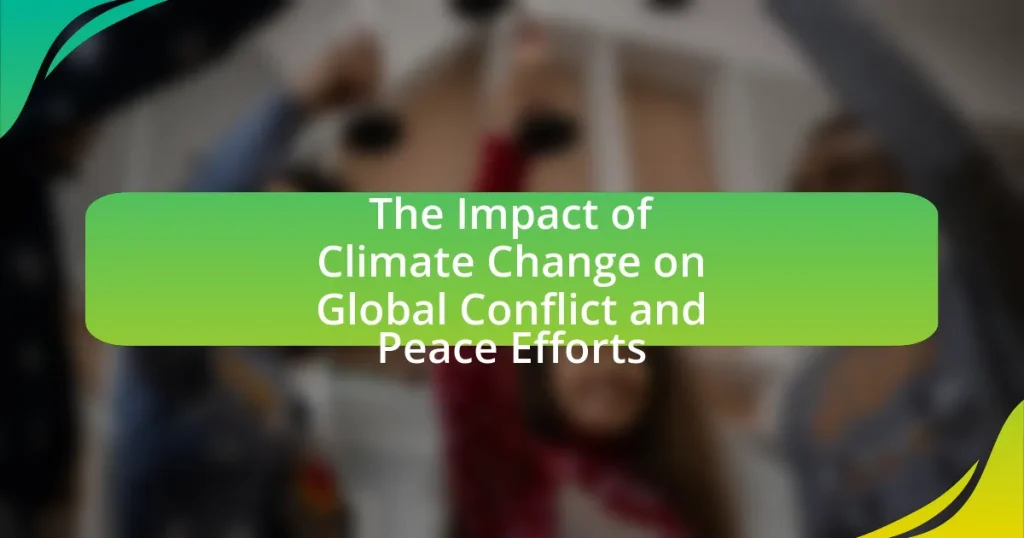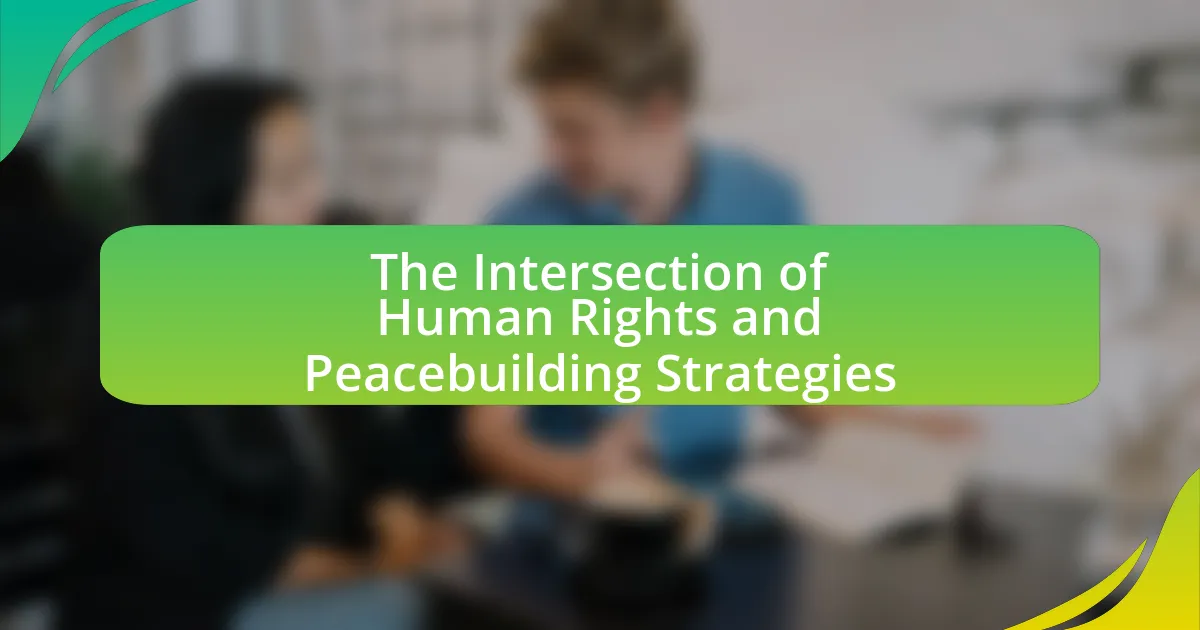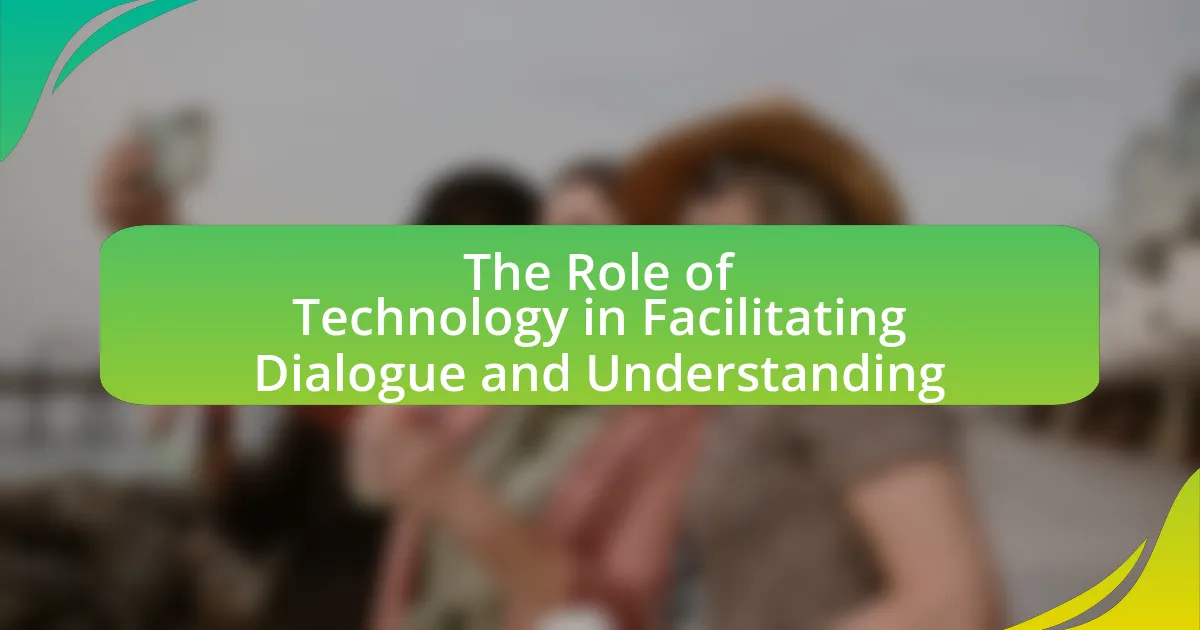The article examines the relationship between climate change and global conflict, highlighting how climate-induced resource scarcity, particularly concerning water and arable land, exacerbates tensions and competition among communities. It discusses historical examples, such as the Syrian civil war and the Darfur conflict, illustrating how environmental stressors can catalyze social unrest and violence. The article emphasizes the importance of integrating climate resilience strategies into peacebuilding efforts and outlines potential solutions, including sustainable resource management and international cooperation, to mitigate the impact of climate change on conflict. Additionally, it explores the role of education and community engagement in fostering awareness and promoting peace in the context of climate challenges.

What is the relationship between climate change and global conflict?
Climate change significantly contributes to global conflict by exacerbating resource scarcity, particularly water and arable land. As temperatures rise and weather patterns become more erratic, regions already facing socio-economic challenges experience intensified competition for dwindling resources. For instance, the 2011 Syrian civil war has been linked to a severe drought that devastated agricultural production, leading to mass migration and social unrest. Research from the National Academy of Sciences indicates that climate-related factors can increase the likelihood of conflict by up to 50% in vulnerable regions. This relationship underscores the critical need for addressing climate change as a factor in global stability and peace efforts.
How does climate change contribute to resource scarcity?
Climate change contributes to resource scarcity by altering weather patterns, leading to reduced agricultural yields and diminished freshwater supplies. For instance, rising temperatures and changing precipitation patterns can result in droughts, which have been documented to decrease crop production by up to 50% in some regions, as seen in the Sahel and parts of South Asia. Additionally, climate change exacerbates the depletion of freshwater resources; the World Bank reports that by 2050, up to 1.7 billion people could face water scarcity due to climate-related factors. This scarcity of essential resources can heighten competition among communities and nations, increasing the potential for conflict over dwindling supplies.
What resources are most affected by climate change?
Water resources are most affected by climate change. Climate change leads to altered precipitation patterns, resulting in droughts and floods that disrupt freshwater availability. According to the Intergovernmental Panel on Climate Change (IPCC), by 2050, up to 5 billion people could be living in areas with limited water resources due to climate impacts. Additionally, agricultural resources are significantly impacted, as changing temperatures and weather patterns affect crop yields and food security. The Food and Agriculture Organization (FAO) reports that climate change could reduce global crop yields by up to 30% by 2050, exacerbating food scarcity and potential conflicts over resources.
How does resource scarcity lead to conflict?
Resource scarcity leads to conflict by intensifying competition among individuals and groups for limited resources such as water, food, and land. This competition can escalate tensions, particularly in regions already experiencing social, economic, or political instability. For instance, the 2011 Syrian civil war was partly fueled by a severe drought that devastated agricultural production, leading to mass migration and increased social unrest. Studies indicate that resource scarcity can increase the likelihood of conflict by up to 50%, as seen in various historical and contemporary contexts where environmental stressors exacerbate existing grievances and power struggles.
What historical examples illustrate the link between climate change and conflict?
Historical examples illustrating the link between climate change and conflict include the Syrian Civil War and the Darfur conflict. In Syria, a severe drought from 2006 to 2011, attributed to climate change, led to crop failures and mass migration from rural areas to cities, exacerbating social tensions and contributing to the outbreak of civil war. Similarly, in Darfur, prolonged drought and desertification in the early 2000s intensified competition for scarce resources, such as water and arable land, leading to violent clashes between different ethnic groups and the escalation of conflict. These instances demonstrate how climate-related stresses can act as a catalyst for social unrest and violence.
How have past climate events influenced wars or conflicts?
Past climate events have significantly influenced wars and conflicts by exacerbating resource scarcity and triggering mass migrations. For instance, the Syrian Civil War, which began in 2011, was preceded by a severe drought from 2006 to 2010 that devastated agricultural production, leading to food shortages and economic instability. This environmental stress contributed to social unrest and ultimately escalated into armed conflict. Similarly, the collapse of the Mayan civilization around the 9th century is attributed to prolonged droughts that led to food shortages, societal breakdown, and warfare among city-states. These historical examples illustrate how climate-induced resource scarcity can act as a catalyst for conflict.
What lessons can be learned from these historical examples?
Historical examples demonstrate that climate change exacerbates resource scarcity, leading to increased conflict. For instance, the Syrian civil war was significantly influenced by a severe drought from 2006 to 2011, which devastated agricultural production and displaced rural populations, contributing to social unrest. Additionally, the Darfur conflict in Sudan was fueled by competition over diminishing water and arable land due to climate variability. These instances illustrate that effective climate adaptation strategies are essential for mitigating conflict risks, emphasizing the need for integrated approaches that address both environmental sustainability and social stability.
Why is understanding this relationship important for peace efforts?
Understanding the relationship between climate change and global conflict is crucial for peace efforts because climate change exacerbates resource scarcity, leading to increased tensions and potential violence. For instance, the United Nations Environment Programme reports that climate-related disasters have displaced millions, creating competition for dwindling resources such as water and arable land. This competition can ignite conflicts, particularly in vulnerable regions, making it essential for peacebuilding initiatives to incorporate climate resilience strategies. By addressing the underlying environmental factors that contribute to conflict, peace efforts can be more effective and sustainable, ultimately reducing the likelihood of violence and fostering stability.
How can awareness of climate-related conflicts inform policy-making?
Awareness of climate-related conflicts can significantly inform policy-making by enabling governments to anticipate and mitigate potential resource-based disputes. For instance, the United Nations Environment Programme has reported that climate change exacerbates resource scarcity, leading to increased tensions and conflicts over water and arable land, particularly in vulnerable regions like Sub-Saharan Africa and the Middle East. By integrating this understanding into policy frameworks, decision-makers can develop proactive strategies that address the root causes of conflict, such as investing in sustainable resource management and enhancing community resilience to climate impacts. This approach not only fosters peace but also aligns with international commitments to sustainable development and climate adaptation.
What role do international organizations play in addressing these issues?
International organizations play a crucial role in addressing the issues related to climate change and its impact on global conflict and peace efforts by facilitating cooperation among nations, providing resources, and promoting sustainable practices. For instance, the United Nations Framework Convention on Climate Change (UNFCCC) brings together countries to negotiate agreements aimed at reducing greenhouse gas emissions, which can mitigate climate-related conflicts over resources. Additionally, organizations like the World Bank offer financial assistance and technical support for climate adaptation projects, helping vulnerable regions build resilience against climate-induced disruptions. These efforts are essential as studies indicate that climate change exacerbates resource scarcity, leading to increased tensions and conflicts, particularly in regions already facing socio-economic challenges.
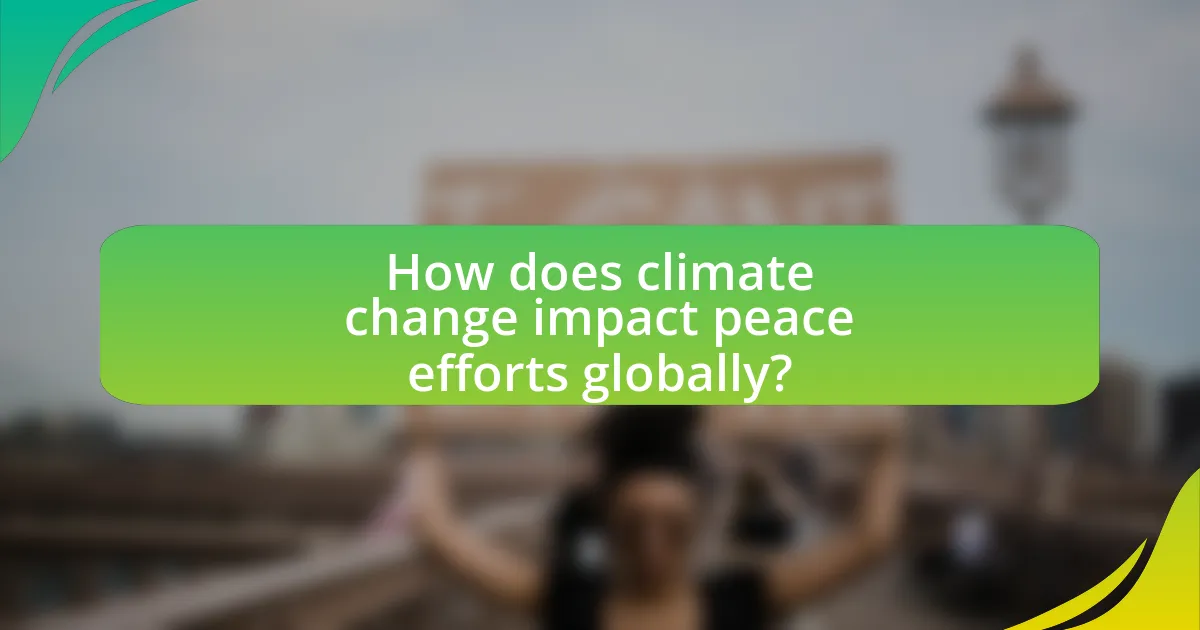
How does climate change impact peace efforts globally?
Climate change significantly undermines peace efforts globally by exacerbating resource scarcity, increasing migration pressures, and heightening the risk of conflict. For instance, the United Nations has reported that climate-related disasters, such as droughts and floods, can lead to food and water shortages, which in turn can fuel tensions between communities and nations. A study by the World Bank indicates that by 2030, climate change could force over 140 million people to migrate within their countries due to environmental factors, creating potential flashpoints for conflict. Furthermore, the Intergovernmental Panel on Climate Change (IPCC) highlights that regions already experiencing political instability are particularly vulnerable to the impacts of climate change, which can further destabilize these areas and hinder peacebuilding efforts.
What are the main challenges to peace efforts posed by climate change?
Climate change poses significant challenges to peace efforts by exacerbating resource scarcity, increasing migration pressures, and heightening the frequency of natural disasters. Resource scarcity, particularly regarding water and arable land, can lead to competition and conflict among communities and nations, as seen in regions like the Sahel, where droughts have intensified tensions. Additionally, climate-induced migration can create instability in host regions, as displaced populations may strain local resources and services, leading to social unrest. Furthermore, the increasing frequency of natural disasters disrupts governance and can overwhelm humanitarian responses, undermining peacebuilding initiatives. These interconnected challenges illustrate how climate change directly threatens global peace and security.
How does climate change affect migration patterns?
Climate change significantly affects migration patterns by increasing the frequency and severity of environmental disasters, which displace populations. For instance, rising sea levels threaten coastal communities, leading to migration from affected areas; the United Nations estimates that by 2050, climate change could displace over 200 million people globally. Additionally, extreme weather events, such as hurricanes and droughts, disrupt livelihoods, prompting individuals to seek more stable living conditions elsewhere. This phenomenon is evident in regions like Sub-Saharan Africa, where prolonged droughts have led to increased migration towards urban centers and other countries.
What is the impact of climate-induced migration on conflict zones?
Climate-induced migration significantly exacerbates tensions in conflict zones by increasing competition for scarce resources. As populations displaced by climate events, such as droughts and floods, move into already unstable areas, they often encounter existing grievances among local communities. For instance, a study by the United Nations High Commissioner for Refugees (UNHCR) indicates that regions experiencing high levels of migration due to climate change see a rise in conflict incidents, as newcomers compete for water, land, and employment opportunities. This competition can lead to social unrest, violence, and further destabilization, particularly in areas already vulnerable to conflict.
How can peacebuilding initiatives adapt to climate change?
Peacebuilding initiatives can adapt to climate change by integrating environmental sustainability into their frameworks and strategies. This adaptation involves assessing climate-related risks that may exacerbate conflicts, such as resource scarcity and displacement. For instance, the United Nations Environment Programme emphasizes the need for peacebuilding efforts to include environmental considerations, as climate change can lead to increased competition over dwindling resources, which historically has been a catalyst for conflict. By incorporating climate resilience into peacebuilding, initiatives can address the root causes of conflict and promote long-term stability.
What strategies can be implemented to mitigate climate-related conflicts?
To mitigate climate-related conflicts, strategies such as enhancing resource management, promoting sustainable development, and fostering community resilience can be implemented. Effective resource management involves equitable distribution of water and land, which can reduce competition and tensions among communities. Promoting sustainable development through policies that encourage renewable energy and conservation can address the root causes of resource scarcity. Additionally, fostering community resilience by investing in education and infrastructure helps communities adapt to climate impacts, thereby reducing vulnerability to conflict. These strategies are supported by research indicating that proactive measures in resource management and community engagement can significantly lower the risk of conflict arising from climate change.
How can local communities be empowered in peace efforts related to climate change?
Local communities can be empowered in peace efforts related to climate change by fostering inclusive decision-making processes that engage community members in climate action initiatives. This empowerment can be achieved through education and training programs that enhance local knowledge about climate resilience and conflict prevention strategies. For instance, the United Nations Development Programme emphasizes the importance of local participation in climate adaptation projects, which can reduce vulnerability and promote social cohesion. Additionally, providing access to resources, such as funding for community-led projects, can enable local groups to implement sustainable practices that mitigate climate impacts and reduce conflict potential.
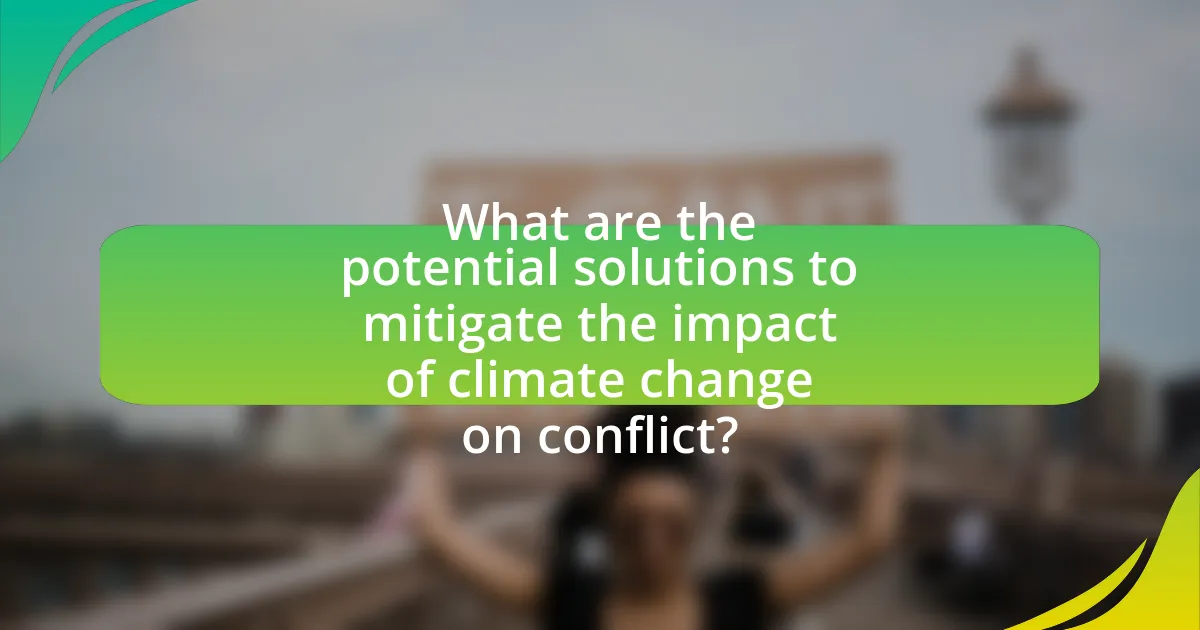
What are the potential solutions to mitigate the impact of climate change on conflict?
Potential solutions to mitigate the impact of climate change on conflict include enhancing climate resilience, promoting sustainable resource management, and fostering international cooperation. Enhancing climate resilience involves investing in infrastructure that can withstand climate-related shocks, which reduces vulnerability and potential conflict over scarce resources. Promoting sustainable resource management ensures equitable access to water and land, addressing the root causes of competition and conflict. Fostering international cooperation through treaties and agreements, such as the Paris Agreement, encourages countries to work together on climate issues, thereby reducing tensions that may arise from climate-induced migration and resource scarcity. These strategies are supported by research indicating that proactive measures can significantly lower the risk of conflict associated with climate change.
How can international cooperation address climate-related conflicts?
International cooperation can address climate-related conflicts by facilitating resource sharing, enhancing adaptive capacity, and promoting conflict resolution mechanisms. Collaborative efforts among nations can lead to joint initiatives that manage shared resources, such as water and arable land, which are often points of contention exacerbated by climate change. For instance, the 1997 United Nations Watercourses Convention encourages countries to cooperate on transboundary water management, reducing tensions over water scarcity. Additionally, international partnerships can provide technical and financial support for climate adaptation strategies, helping vulnerable regions build resilience against climate impacts, thereby mitigating potential conflicts. The Paris Agreement exemplifies a global commitment to climate action, fostering cooperation that can indirectly reduce the risk of conflicts arising from climate-related stresses.
What frameworks exist for international collaboration on climate and peace?
International collaboration on climate and peace is facilitated by frameworks such as the Paris Agreement, the United Nations Framework Convention on Climate Change (UNFCCC), and the Sustainable Development Goals (SDGs). The Paris Agreement, adopted in 2015, aims to limit global warming and includes provisions for enhancing resilience to climate impacts, which can mitigate conflict risks. The UNFCCC provides a platform for countries to negotiate climate action and emphasizes the importance of addressing climate change as a factor in global security. The SDGs, particularly Goal 13 (Climate Action) and Goal 16 (Peace, Justice, and Strong Institutions), promote the integration of climate action into peacebuilding efforts. These frameworks collectively underscore the interconnection between climate change and peace, highlighting the necessity for collaborative approaches to address both challenges effectively.
How can countries work together to manage shared resources affected by climate change?
Countries can work together to manage shared resources affected by climate change through collaborative agreements and joint management frameworks. For instance, transboundary water management agreements, such as the 1997 United Nations Convention on the Law of the Non-Navigational Uses of International Watercourses, facilitate cooperation among nations sharing water resources. These agreements often include provisions for data sharing, joint monitoring, and conflict resolution mechanisms, which are essential for addressing the impacts of climate change on water availability. Additionally, countries can engage in regional partnerships, like the Nile Basin Initiative, which promotes sustainable management of the Nile River among its member states, ensuring equitable resource distribution and reducing potential conflicts. Such collaborative efforts are crucial as climate change exacerbates resource scarcity, making joint management vital for maintaining peace and stability in affected regions.
What role does education play in reducing conflict related to climate change?
Education plays a crucial role in reducing conflict related to climate change by fostering awareness, promoting sustainable practices, and encouraging critical thinking. By equipping individuals with knowledge about climate change impacts and solutions, education empowers communities to adapt and mitigate risks, thereby decreasing competition over scarce resources. For instance, studies show that educational programs focused on environmental sustainability can lead to improved resource management and conflict resolution strategies, as seen in various regions where education initiatives have successfully reduced tensions over water and land use.
How can educational programs promote awareness of climate issues and peace?
Educational programs can promote awareness of climate issues and peace by integrating climate education into curricula, fostering critical thinking about environmental impacts on social stability. For instance, programs that include case studies on how climate change exacerbates resource scarcity can illustrate the link between environmental degradation and conflict. Research indicates that areas facing severe climate impacts, such as droughts or floods, often experience increased tensions and violence, highlighting the necessity of understanding these dynamics. By equipping students with knowledge about climate science and its socio-political implications, educational initiatives can cultivate informed citizens who advocate for sustainable practices and peaceful conflict resolution.
What initiatives have been successful in fostering dialogue and understanding?
Successful initiatives in fostering dialogue and understanding include the United Nations Framework Convention on Climate Change (UNFCCC) and the Paris Agreement. These initiatives have facilitated international cooperation by bringing together countries to discuss climate change impacts, which are increasingly linked to global conflict. For instance, the Paris Agreement, adopted in 2015, aims to unite nations in combating climate change and has led to collaborative efforts that enhance mutual understanding and shared goals among diverse stakeholders. Additionally, local community-based programs, such as the Climate and Conflict Initiative, have effectively engaged affected populations in dialogue, promoting peacebuilding through shared climate adaptation strategies. These initiatives demonstrate a clear correlation between climate action and conflict resolution, as evidenced by the increased participation of nations in climate negotiations and the establishment of peace dialogues in regions affected by climate-related stressors.
What practical steps can individuals take to contribute to peace in the context of climate change?
Individuals can contribute to peace in the context of climate change by adopting sustainable practices, advocating for climate justice, and engaging in community resilience efforts. Sustainable practices include reducing carbon footprints through energy conservation, using public transportation, and supporting renewable energy sources, which collectively mitigate climate change impacts that can exacerbate conflict. Advocating for climate justice involves supporting policies that address the disproportionate effects of climate change on vulnerable populations, thereby promoting social equity and stability. Engaging in community resilience efforts, such as participating in local environmental initiatives or disaster preparedness programs, fosters cooperation and solidarity among community members, which is essential for maintaining peace in the face of climate-related challenges.
